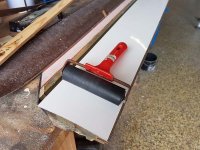Im pretty familiar with cabinetry too but the thing with the GC rails. I believe they are made similar to a typical countertop with a curved backplash. I think they used a mold to hold the formica and then with heat and pressure formed the particleboard rail. the bonding of the rail, I imagine as part of that original molding process. its similar if a shop were to make a countertop with a particleboard backsplash wiht it's typical curvature. a cabinet shop wouldnt own that sort of specialied press so they may buy that sort of countertop.
the problem , as I see it is that it is curved and so you might use something like a hydraulic clamp to hold your Formica to the surface , but it will wan to spring towards being flat without heat being used to keep that curved form to the formica, otherwise you are basically expecting the glue to forever hold the pressure of the Formica wanting to return to its flattened position.
if you used a thick veneer and not formica that may work , If you were to make a formed curved mold and heat he formica up to try to make it permanently accept the bend , that may help. If it were wood it may be happy enough to be bending across its grain. you could remove the formica and replace it with a thick rosewood veneer? black walnut maybe?
if you were to use the wrong paint then it may not stick or it may wear though, I'd think about something like imron epoxy paint. and sand the formica to get enough hook that the paint sticks, after that maybe auto paint with a clearcoat. epoxy will not stick well to many plastics, especially if they are smooth, It might stick if you were to say roughly sand it with 120 or so.
I believe the sides are flatter and this would present less of a problem, I think I'd just save the old ones and maybe just try to recreate those using the OEM ones as a pattern. maybe use decent plywood and a nice veneer or similar.
I have a cheaper 1970 4x8 made by brunswick , I was thinking of doing similar. painting the rails re creating the side pieces..
Im not sure Illl use it, maybe donate it to some one.. or I had an idea ot use it's slate to trim out my fireplace ;-)
you can get thin plywood with all it's laminates running the same direction , Normal plywood has its plys in alternating directions. that stuff can be bent conical like a pipe to about a 6" diameter.. Its kind of interesting, I believe it's called "rubber"
if you wanted to put a bend in particleboard you might try a mold and experiment heating it, you may find you cna instill a permanent bend. I dont think I'd rely on glue to keep that sort of form permanently because although you may be able to form the curvature and use glue to hold it, the stress will always be there and I think it will win over the glue bond eventually. I think heat needs to be used to remove that stress and make the Formica "want" to lie with a curvature.
laquer is pretty good at sticking to anything, that might help, it has less cratch resistance than formica. I have a little brunswich with wood rails and I re laquered it, used a toner than clear lacquer.. the rest of it has OEM laquer , and it wasmade in about 1964, the laquer finsh is otherwise wearing very well. you can get laquer in any color, its easy to spray, smells a but that dissipates fast.
laquer is different from other coatings in that it melts into itself, becomes part of it's underlying layers. car paint or epoxy does not, that sticks by it's "hook" alcohol spills do wreck laquer jobs, same with shellac. epoxy is very tough.

